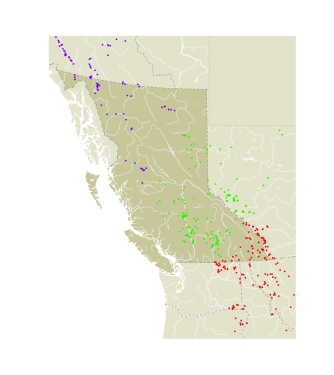AdultThe Northern Blue, Anna's Blue, and Melissa's Blue are the only BC blues where the submarginal orange spots of the ventral hindwing extend into the ventral forewing. Northern Blue males are a uniform violet blue with obvious black submarginal spots on the dorsal hindwings. Females are a uniform brown, usually with submarginal orange spots on the dorsal hindwing that can extend to the forewing. Where the Northern Blue occurs near the very similar Melissa's Blue, the two species are difficult to tell apart in the field. The only clue is that the Northern Blue will usually be found above 1,000 m and Melissa's Blue below 1,000 m. Otherwise, the male genitalia are the only reliable character for separating males. Lycaeides anna and L. idas have nearly identical genitalia. Females are identified by their association with males. In long series of females, the orange submarginal spots of the dorsal hindwing are much narrower for L. idas than for L. melissa. Since the Northern Blue in North America has a very different larval foodplant (the heather family) and a very different ventral wing from L. anna and is allopatric to L. anna, we separate the two species. It is also likely that this species is not the same as the Palearctic L. idas.
Immature StagesUndescribed. Apparently all descriptions of immatures of this genus under the name scudderi in the northeastern USA and Ontario refer to L. melissa samuelis Nabokov, 1944.
SubspeciesIn northwestern BC the Beringian subspecies, L.i. alaskensis (Chermock, 1945) (TL: Fort Yukon, AK), with very blue females is found. In the boreal forest habitat of northeastern and central BC, the boreal subspecies, L.i. scudderi (W.H. Edwards, 1861) (TL: mouth of the Saskatchewan R., MB), occurs. It has females with some blue but the ventral pattern is much more distinct than that of the Beringian subspecies. It ranges south to near Lillooet, Salmon Arm, and Revelstoke. East of the Okanagan Valley bottom in southeastern BC, the Rocky Mountain subspecies, L.i. atrapraetextus (Field, 1939) (TL: Priest River, ID) [= ferniensis (Chermock, 1945); TL: Fernie, BC] is found. It is closest to subspecies scudderi but is smaller and darker.
